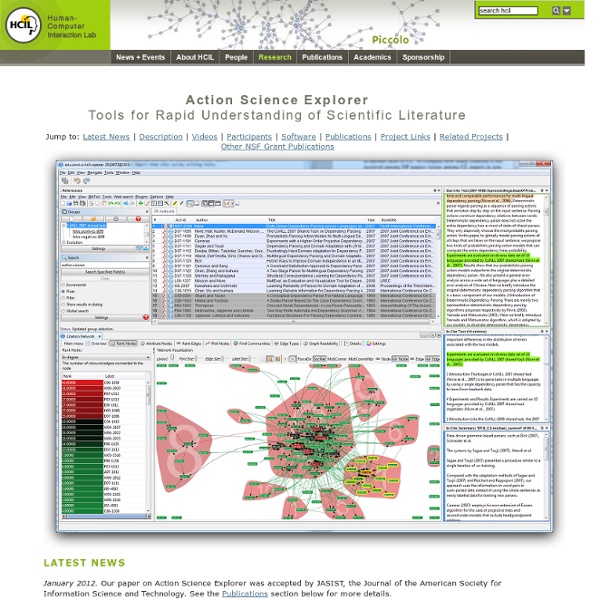Circos - Circular Genome Data Visualization
CiteSpace: Visualizing Patterns and Trends in Scientific Literature
Requirements Java Runtime (JRE) You need to have Java Runtime (JRE) installed on your computer before you can run CiteSpace. Make sure you install the JRE that matches to your system. Memory or RAM It is recommended that you should have at least 1024MB (=1GB) of memory on your computer. WebStart versus Download You may use either the WebStart link or the download link. Linux Eric SanJuan, University of Avignon, France, provides the following script. Download the standalone Java 7 tgz archive from oracle official website and use it WITHOUT any system installation: # to download Java 7 standalone archive wget # to extract files from the archive tar -xzf jre-7u9-linux-i586.tar.gz # to run CiteSpace wget # to run CiteSpace using previous Java 7 jre1.7.0_09/bin/javaws citespace.jnlp Mac Data Three sample datasets are provided below. 1. 2.
instaGrok | A new way to learn
CiteSpace: visualizing patterns and trends in scientific literature
CiteSpace is a freely available Java application for visualizing and analyzing trends and patterns in scientific literature. It is designed as a tool for progressive knowledge domain visualization (Chen, 2004). It focuses on finding critical points in the development of a field or a domain, especially intellectual turning points and pivotal points. CiteSpace supports structural and temporal analyses of a variety of networks derived from scientific publications, including collaboration networks, author co-citation networks, and document co-citation networks. The primary source of input data for CiteSpace is the Web of Science. Notes: You need to have Java Runtime installed on your computer. Can I access an expired version? Yes. How should I get the new version? New versions of CiteSpace will be available as a downloadable dist.zip file. Follow the CiteSpace Manual and Tutorial links for information on how to get started. Disclaimer CiteSpace is made available as it is.
Uberlink | Insight From Online Networks
12 Visualizations That Will Change the Way You View Scale in Your World
Scale is a simple concept. From a very early age, children know about big and small, heavy and light, more and less. Extreme scales, however, are another story. Try to imagine, for example, the size of the universe… or $1 trillion made up entirely of dollar bills. Exactly. Grasping the actual quantities involved in extreme scales can be difficult, which makes managing scale in visualizations an interesting problem. Below are 12 visualizations that try to show things at extreme scales. 1. 2. 3. 4. 5. 6. 7. 8. 9. Infographic originally published on Mashable.com. 10. xkcd’s creator, Randall Munroe seems to enjoy visualizations of scale. 11. 12. Humans all fit within a small range of sizes, weights, and lifespans, and the quantities we deal with typically fit in small ranges as well. Drew Skau is a PhD Computer Science Visualization student at UNCC, with an undergraduate degree in Architecture.
mapequation.org
Home
Elements and Standards Learning Tool
In this section, we offer an interactive model which details the analysis and assessment of reasoning, and enables you to apply the model to real life problems. On this page we introduce the analysis and assessment of reasoning. To skip this introduction and go directly to the model, see the links near the bottom of this page. Why the Analysis of Thinking Is Important Everyone thinks; it is our nature to do so. But much of our thinking, left to itself, is biased, distorted, partial, uninformed, or downright prejudiced. Yet the quality of our life and of what we produce, make, or build depends precisely on the quality of our thought. All Thinking Is Defined by the Eight Elements That Make It Up Eight basic structures are present in all thinking: Whenever we think, we think for a purpose within a point of view based on assumptions leading to implications and consequences. Each of these structures has implications for the others.
Projects - *ORA
Overview | People | Sponsors | Publications | Hardware Requirements | Software | Training & Sample Data *ORA is a dynamic meta-network assessment and analysis tool developed by CASOS at Carnegie Mellon. It contains hundreds of social network, dynamic network metrics, trail metrics, procedures for grouping nodes, identifying local patterns, comparing and contrasting networks, groups, and individuals from a dynamic meta-network perspective. Based on network theory, social psychology, operations research, and management theory a series of measures of “criticality” have been developed at CMU. *ORA can be applied both within a traditional organization or on covert networks. Applying *ORA to an organization, key actors who by virtue of who they know, what they know, and what they are doing are potential risks to the security of a company can be determined. A prototype system exists that is set in the corporate context.



